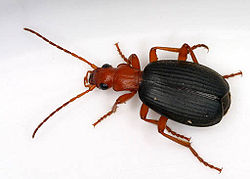Ground beetle
Ground beetles are the Carabidae, a large, cosmopolitan family of beetles. There are more than 40,000 species worldwide, about 2,000 of which are found in North America and 2,700 in Europe.[1] There are a large number of subfaamilies.[2]
| Ground beetles | |
|---|---|

| |
| Golden ground beetle eating an earthworm | |
| Scientific classification | |
| Kingdom: | |
| Phylum: | |
| Class: | |
| Order: | |
| Suborder: | |
| (unranked): | |
| Superfamily: | |
| Family: | Carabidae Latreille, 1802
|
Description
Although their body shapes and colouring vary, most are shiny black or metallic. They have ridged wing covers (elytra). The elytra are fused in some large flightless species.
Almost all carabids have a groove on their foreleg with a comb of hairs used to clean their antennae.[3]
Defensive secretions
They defend themselves with noxious secretions. This is typical for the ancient beetle suborder Adephaga to which they belong. They have paired glands in the lower back of the abdomen. These are well developed, and produce noxious or even caustic secretions used to deter would-be predators.
In bombardier beetles these secretions are mixed with volatile compounds and ejected by a small combustion with a loud popping sound and a cloud of hot and acrid gas. This can injure small mammals, such as shrews, and may kill invertebrate predators outright. To humans, getting "bombed" by a bombardier beetle is a decidedly unpleasant experience. This ability has evolved twice – in the flanged bombardier beetles (Paussinae) which are among the most ancient ground beetles, as well as in the typical bombardier beetles (Brachininae) which are part of a more "modern" lineage.
The Anthiini can squirt their defensive secretions for considerable distances and are able to aim with a startling degree of accuracy; in Afrikaans they are known as oogpisters ("eye-pissers"). Charles Darwin got on the receiving end of a bombardier beetle's defences on a collecting trip in 1828. He discussed this in a letter:
"A Cychrus rostratus once squirted into my eye & gave me extreme pain; & I must tell you what happened to me on the banks of the Cam in my early entomological days; under a piece of bark I found two carabi (I forget which) & caught one in each hand, when lo & behold I saw a sacred Panagaeus cruxmajor; I could not bear to give up either of my Carabi, & to lose Panagæus was out of the question, so that in despair I gently seized one of the carabi between my teeth, when to my unspeakable disgust & pain the little inconsiderate beast squirted his acid down my throat & I lost both Carabi & Panagæus!" [4]
Ecology
Ground beetles often live under the bark of trees, under logs, or among rocks or sand by the edge of ponds and rivers. Most species are carnivorous and actively hunt for any invertebrate prey they can overpower. Some run fast to catch their prey; tiger beetles (Cicindelinae) are certainly fast runners in comparison to their length. Unlike most Carabidae, which are nocturnal, the tiger beetles are active daytime hunters and often brightly coloured. They have large eyes and hunt by sight. Ground beetles of the species Promecognathus laevissimus are specialised predators of the cyanide millipede Harpaphe haydeniana. They can counter the hydrogen cyanide which makes these millipedes poisonous to most carnivores.
References
- ↑ B. Kromp (1999). "Carabid beetles in sustainable agriculture: a review on pest control efficacy, cultivation aspects and enhancement". Agriculture, Ecosystems and Environment. 74 (1–3): 187–228. doi:10.1016/S0167-8809(99)00037-7.
- ↑ "Carabidae Taxa". Carabidae of the World. 2011. Retrieved 24 Jun 2011.
- ↑ John L. Capinera. Encyclopedia of Entomology. p. 1746.
- ↑ Charles Darwin (1846). "Letter to Leonard Jenyns, October 17, 1846".

